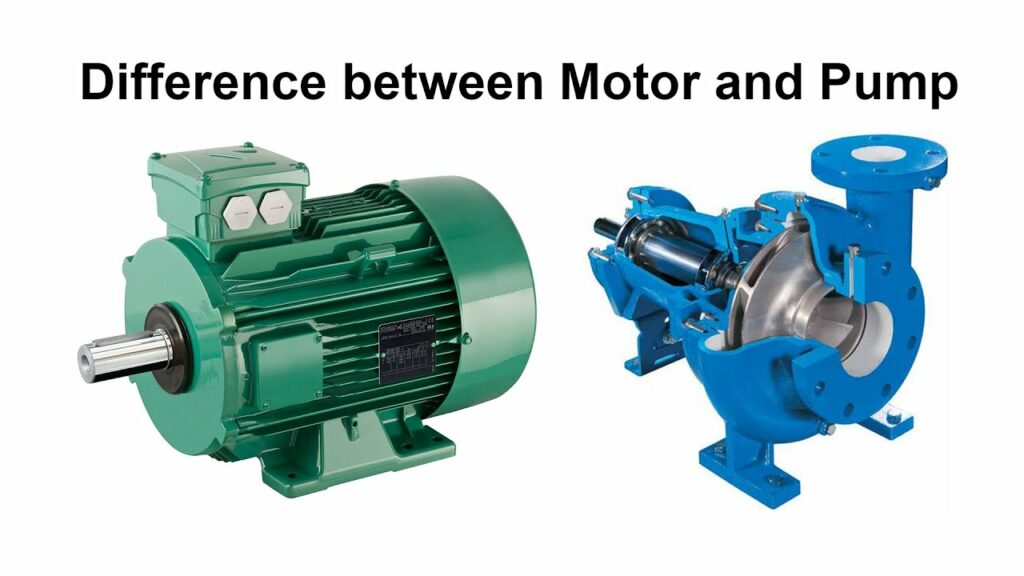The main difference between pump and motor is in their functions and applications. Although both machines have a wide range of engineering applications, the pump is used to transfer the fluid, and the motor converts one form of energy to another.
Pumps and Motors differ primarily in their functions and applications. The pump is used to transport fluid, while the motor transfers one kind of energy to another. Pumps and motors are two of the most crucial outcomes of using industrial tools. Pump and Motor are available from a variety of suppliers and companies, as well as various Manufacturers and distributors, and there are several Pump And Motor For Sale on Linquip.
A full list of pump and motor services is available on the Linquip website, which covers all OEM fleets. Linquip vendors can assist you with this. Please contact Pump and Motor Experts in Linquip to learn more about how to connect with a diverse group of service providers who consistently deliver high-quality products.
Both the pumps and motors have a fundamental function in various engineering areas such as mechanical engineering, civil engineering, electrical engineering, automobile engineering, construction works, robotics, and so on. They are employed for a variety of goals. Both devices are among the most significant inventions ever used in all applications.
A pump is a mechanical machine used to raise or transfer fluids using suction or pressure. The most well-known examples of pumps are the windmill and watermill used to pump water.
The motor is an electro-mechanical device that transforms electrical energy into mechanical energy. Motors are available everywhere, such as computers, hairdryers, electric shaver, dishwashers, coffee grinders, and microwaves.
Difference between Pump and Motor
In this section, we will describe the difference between pump and motor in different cases.
Basics of Pumps and Motors
First, we compare the generalities about the pump and the motor.
Pump
Pumps are standard mechanical devices used to move liquids or gases inside a pipeline or hose, applying suction or pressure or both. They are also used to compress gases or push air into inflatable objects like tires. It makes suction in order to produce pressure causing the liquid to rise to a higher level.
Pumps utilize mechanical energy to draw in, pressurize, or discharge the fluids through the outlet. Pumps are basically powered by a variety of energy sources, including manual operation, electricity, wind power, and engines. Because they offer a wide range of applications, pumps are available in all shapes and sizes, from domestic submersible pumps to centrifugal pumps to large-scale industrial pumps.
Motor
Motors are electro-mechanical machines that convert electrical energy into mechanical energy. Motors account for almost half of the energy consumption in the world. So they play a significant role in a global energy ecosystem.
In the fields of engineering and technology after the invention of electricity, electric motors have been recognized as one of the greatest successes and most important designs the world has ever seen.
Types of Pumps and Motors
Pumps and motors are classified according to their structures and operations as follows:
Pump
There are several methods for classifying pumps, one of the most common of which is a classification based on the process by which the pump affects the fluid. Accordingly, pumps are classified into two basic categories: positive displacement pumps and dynamic pumps like centrifugal pumps. They can also be categorized into velocity pumps, steam pumps, impulse pumps, gravity pumps, and valveless pumps in terms of displacement method.
Positive Displacement Pump
The positive displacement pumps perform the motion of fluids by trapping a certain amount of volume in the discharged pipe, and during the pump operation cycle, the volume being placed is fixed.
Positive displacement pumps are divided into two subsets: reciprocating pumps and rotary pumps. The following figure shows the parts of a reciprocating pump. Reciprocating pumps operate on a mechanism of alternating force and suction action to create the flow. The pump consists of a chamber that expands and contracts, usually generating a pulsing flow through a piston or diaphragm movement. This powerful setup is suitable for applications where viscous liquids are pumped.
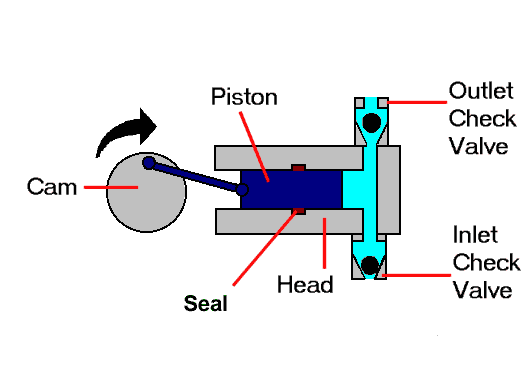
Rotary pumps consist of one or two rotating parts that move in such a way as to create suction. This draws in the fluid that moves by rotating and creates pressure as it passes through the pump. As the pump works, it draws the fluid in and at the same speed expelled, which causes a constant and regular flow. This feature makes it a proper choice to pump a wide range of non-corrosive liquids. The liquids should not contain solid particles as they may clog the rotating parts. The figure below shows a rotary pump.
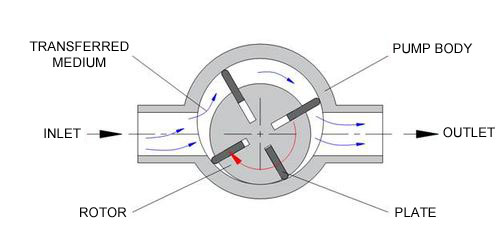
Dynamic Pump
In dynamic pumps, the kinetic energy of the fluid increases. This increase in energy is converted to potential energy (pressure) by the special design of the pump when the velocity is reduced as the flow exits the pump. Dynamic pumps have some characteristics, including continuous energy transfer from the pump to the fluid.
Dynamic pumps can be subdivided into peripheral pumps and turbopumps. In the peripheral turbine, Turbine-like impellers cause an increase in the liquid velocity. Turbopumps are among the most well-known pumps. One of the most widely used turbopumps is the centrifugal pump. Centrifugal pumps use rotating blades to create a vacuum to transfer liquids from one place to another. A radial flow pump is the most typical type of centrifugal pump.
To know more about different types of pumps, you can visit this link.
Motor
Electric motors are generally classified into two general types: AC and DC motors.
DC Motor
A DC motor is a rotary electric motor that turns direct current electrical energy into mechanical energy. The most basic types rely on the forces created by magnetic fields. Almost all types of DC motors have an internal mechanism, electromechanical or electronic, to change the direction of current periodically in part of the motor. DC motors were the first class of motor widely used because they had the ability to be powered from direct-current power distribution systems.
The speed of a DC motor can be regulated over a wide range utilizing variable supply voltage or changing the current strength in its field windings.
Small DC motors are employed in tools, toys, and appliances. Large DC motors are used in the propulsion of electric vehicles, elevators, and drives for steel rolling mills.
AC Motor
AC electric motor is run by an alternating current (AC). The AC motor usually consists of two primary parts: an external stator with coils supplied with AC to generate a rotating magnetic field and an internal rotor connected to the output shaft providing the second rotating magnetic field. The magnetic field of the rotor may be created by permanent magnets, reluctance saliency, or AC or DC electrical windings.
There are two main types of AC motors: induction motors (or asynchronous motors) and synchronous motors. The induction motor always works based on a small difference in speed between the stator rotating magnetic field and the speed of the rotor shaft called slip to induce rotor current in the rotor AC coil. In contrast, the synchronous motor does not operate based on slip-induction and applies either salient poles, permanent magnets, or an independently excited rotor winding.
The growth of power electronics has made it possible to replace DC motors with AC motors in many applications. Common uses of AC motors include pumps, lawn and garden equipment, water heaters, ovens, and motorized off-road equipment.
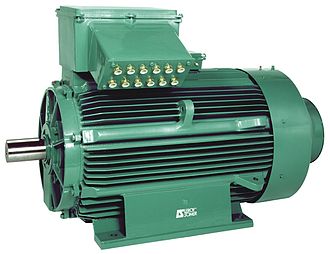
Operation of Pump and Motor
The basis of the pump and motor operation is completely different, which is explained below.
Pump
A pump utilizes forces of nature to transfer liquids or sometimes slurries. Electric motors power the pump to drive the impeller. The working principle of a centrifugal pump is based on giving energy to the liquid using a centrifugal force created by the rotation of an impeller with several blades. The fundamental theory of working of a centrifugal pump comprises of the following steps:
- The fluid enters the casing of the pump at the impeller eye.
- The kinetic energy is transferred to the fluid using the centrifugal force generated by the rotation of the impeller, and the fluid is radially driven towards the impeller periphery.
- The kinetic energy of the fluid is converted to potential energy by conducting it to an expanding volute casing in a volute type centrifugal pump or diffusers in a pump-turbine.
The structure of centrifugal pumps is shown in the following figure:
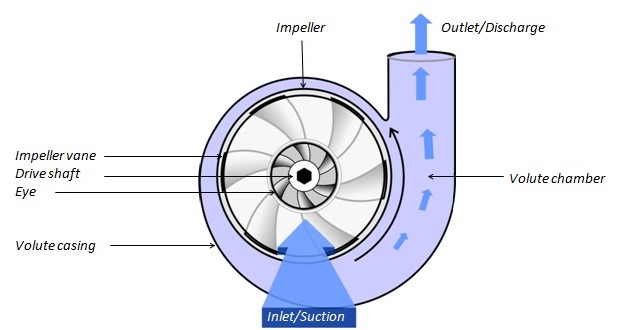
Motor
Most electric motors work by means of the interaction between the magnetic field of the motor and the electric current in a coil to make a torque as a force applied on the motor shaft. Electric motors power can be supplied by direct current (DC) sources, like batteries or rectifiers, or alternating current (AC) sources, like a power grid, electrical generators, or inverters. A motor works based on Faraday’s law of electromagnetic induction, one of the most fundamental laws of electromagnetism.
Electric motors provide a linear or rotary force (in the form of torque) to propel an external mechanism, such as a fan. Electric motors are usually designed for continuous rotation or for linear motion over a considerable distance compared to their size.
Compared with standard internal combustion engines (ICEs), electric motors are lightweight, smaller in size, and provide more power output. Also, motors are mechanically easier and cheaper to manufacture while providing instantaneous and consistent torque with higher response speed, higher efficiency, and less heat generation. However, motors are not as available and common as ICEs in movable applications such as cars and buses because motors require large and expensive batteries. In contrast, ICEs need relatively small fuel tanks.
Applications of Pump and Motor
Pumps and motors play an important role in various parts of our daily lives as well as in different industries. Some of these applications are mentioned in this section.
Pump
Pumps are used in a wide range of purposes such as pumping water from wells, pond filtering and aeration, aquarium filtering, in the car industry for water-cooling and fuel injection, in the industry of energy to pump oil and natural gas, or in cooling towers and other parts of heating, air conditioning systems, and ventilation. Also, in the medical industry, pumps are applied for biochemical processes in developing and producing medicine, and artificial body parts, including the artificial heart and penile prosthesis.
Motor
Motors are almost everywhere, like in fans, compressors, dishwashers, robotics, conveyor systems, electric vehicles, hoists, lifts, vacuum cleaners, lathes, grinders, shearing machines, and so on.
The efficiency of Pump and Motor
For both pump and motor, some losses prevent them from being 100% efficient. In this section, we will explain these items.
Pump
Losses in a pump are classified into two types: hydraulic losses and non-hydraulic losses. The first category is the losses that occur as fluid flows into the pump.
Hydraulic losses
Hydraulic losses are due to circulatory flow, friction, and shock phenomenon or eddy.
The interaction between circulatory flow and the primary flow causes the exit velocity of the blades to be non-uniform. Moreover, friction losses take place due to the turbine surface area in contact with the fluid. So, the friction makes a change in the flow direction of the fluid. An improper entrance angle to the blade produces shock losses in off-design working conditions.
Non-hydraulic losses
Non-hydraulic losses are generally related to mechanical losses and leakage losses. Leakage losses are subdivided into internal and external leakage losses. Internal leakage occurs because of improper clearance between the casing and the impeller, which makes an unintended flow down to the suction side. External leakage losses also occur due to problems in the machine casing sealing and the bearings sealing.
Mechanical losses are those made due to the friction of the disc between impeller and liquid filling the clearance between impeller and casing. These also occur because of mechanical friction in contact points such as bearings.
All the mentioned losses cause the output power of a pump to be not equal to available energy to the fluid provided by the performance of the pump. Thus, the efficiency of a pump is given as follows:
\eta=\frac{Q\Delta P}{P_{input}}
where Q is the flow rate in m3/s, Δp is the total pressure difference between the pump outlet and inlet, and Pinput is the power required by the pump.
Motor
Copper losses or electrical power losses in the primary rotor and secondary stator winding resistance can be expressed as the following equation:
P_{cl}=RI^{2}
where, R and I are resistance (in Ω) and current (in A), respectively.
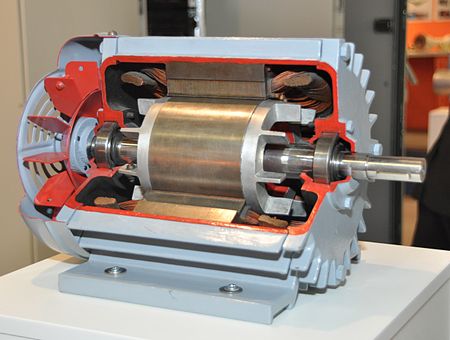
Iron losses, another type of loss, are the result of dissipated magnetic energy when the magnetic field of the motor is applied to the stator core.
Mechanical losses include friction in the parts of the motor like the bearings and other parts of the machine, such as the fan for air cooling.
Stray losses are those remaining after copper losses, iron losses, and mechanical losses. The largest share of the stray losses is harmonic energies produced when the motor is running under load. These energies are dissipated in the form of currents in the copper winding, harmonic flux components in the iron components, and leakage in the laminate core.
So, the motor efficiency can be written as the following relation:
\eta =\frac{P_{out}}{P_{in}}
In the above equation, Pin is the electric power delivered to the motor and Pout is the shaft output power.
What Is the Difference Between Motor and Pump Provide At Least Two Examples for Both the Cases?
The windmill and watermill used to pump water are the most well-known instances of pumps. An electric motor is an electromechanical machine that converts electrical energy to mechanical energy. Computers, electric shavers, hairdryers, coffee grinders, dishwashers, and microwaves all have motors in them.
A pump is a device that uses forces such as air to transfer fluids. Because the moving part begins to move, the air pushes forward from the way. These are usually turned on by electric motors that operate a compressor. As a result of the water flow, a partial vacuum might be generated, which is later filled with extra air.
Download Difference Between Pump and Motor PDF
Read More In Linquip
- Difference Between Pump and Turbine
- Difference Between Pump and Compressor
- Types of Water Pumps and Their Principles
- Difference Between Air Compressor and Air Pump
- A Cheat Sheet For The Types of Pump Couplings
- Types of Submersible Pumps: All Classification With Details
- Different Types of Hydraulic Pumps: a Complete Guide
- Different Types of Pumps: Ultimate Guide in 2021
- The 7 Best RV Water Pump In 2022 (Clear Guide + Review)
- The 10 Best Electric Air Pump in 2022 (Clear Guide)
- The Best HVAC Vacuum Pump in 2022 (Clear Guide)
- 9 Different Types of Rotary Pumps + PDF
- The 5 Best Well Pump in 2022 (Clear Guide)
- The 10 Best Condensate Pumps of 2022: A Complete Guide

